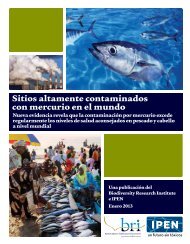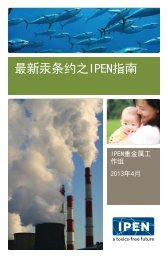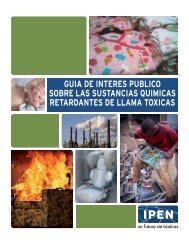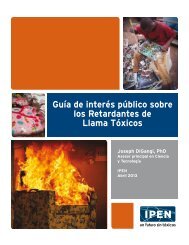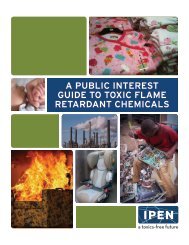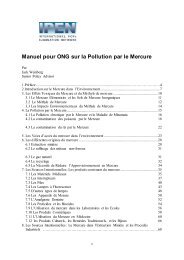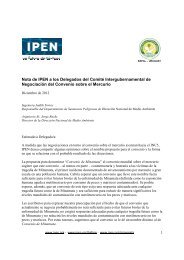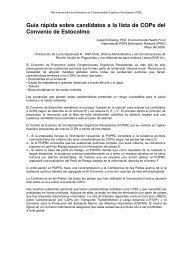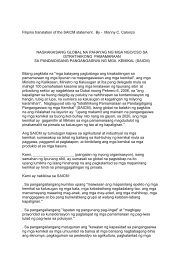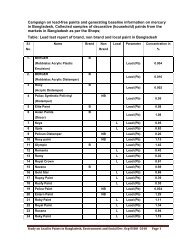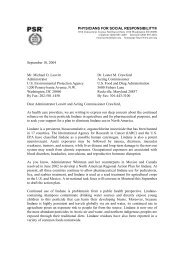The UNDP-GEF POPs Resource Kit - International POPs Elimination ...
The UNDP-GEF POPs Resource Kit - International POPs Elimination ...
The UNDP-GEF POPs Resource Kit - International POPs Elimination ...
Create successful ePaper yourself
Turn your PDF publications into a flip-book with our unique Google optimized e-Paper software.
BACKGROUND<br />
6. For more than 30 years, awareness has been growing about the threats posed to<br />
human health and the global environment by the ever-increasing release in the natural<br />
environment of synthesized chemicals. <strong>The</strong> number of synthesized chemicals is now beyond<br />
three million and is growing at a rate of several hundred thousand a year of which 300-500<br />
reach the stage of commercial production. It is estimated that up-to one third of the total<br />
production of these chemicals reaches the environment 1 . Mounting evidence of damage to<br />
human health and the environment has focused the attention of the international community<br />
on a category of these substances referred to as Persistent Organic Pollutants (<strong>POPs</strong>). Some<br />
of these substances are pesticides, while others are industrial chemicals or unwanted byproducts<br />
of industrial processes or combustion. <strong>POPs</strong> are characterized by persistence – the<br />
ability to resist degradation in various media (air, water and sediments) for months and even<br />
decades; bio-accumulation - the ability to accumulate in living tissues at levels higher than<br />
those in the surrounding environment; and potential for long range transport – the potential<br />
to travel great distances from the source of release through various media (air, water, and,<br />
migratory species). <strong>The</strong>se chemical substances can disrupt endocrine systems, suppress<br />
immune system functions, and induce reproductive and developmental changes. <strong>The</strong><br />
evidence of detrimental effects on living organisms at the level of entire populations of some<br />
<strong>POPs</strong> demonstrates the threat to biodiversity, and the potential for disruption at the<br />
ecosystem level. Organisms at the top of food chains, including humans, usually accumulate<br />
the highest body burden over their life time.<br />
THE <strong>GEF</strong> AND POPS<br />
7. <strong>The</strong> involvement of the <strong>GEF</strong> in addressing global contaminants dates back to 1995,<br />
when the <strong>GEF</strong> Council, recognizing the global significance of the problems posed by<br />
persistent toxic substances – PTS, which include <strong>POPs</strong>, heavy metals and organo-metallic<br />
compounds - approved the eligibility of actions aimed at “limiting the releases of<br />
contaminants causing priority concerns” in the international waters focal area. Specific<br />
reference to persistent organic pollutants is made in the Contaminant Based Operational<br />
Program (#10). <strong>The</strong> program scope of OP10 focuses on specific contaminants rather than a<br />
specific water-body. Under the present provisions, projects utilize demonstrations to<br />
overcome barriers to adoption of best practices, and funds the incremental costs of projects<br />
designed to achieve global environmental benefits within the context of the international<br />
waters focal area.<br />
8. In the period March 1998 – April 1999, in response to a finding of the Overall<br />
Performance Evaluation that called for an increased effort in this field, the <strong>GEF</strong> defined<br />
near-<br />
term activities aimed at enhancing <strong>GEF</strong>’s catalytic role. <strong>The</strong> objectives set forth in the<br />
program<br />
1 Report on the STAP Brainstorming on <strong>POPs</strong>, Barbados, Feb. 2000<br />
94 ----------------------------------------------------------------------------------------<strong>UNDP</strong>-<strong>GEF</strong> <strong>POPs</strong> <strong>Resource</strong> <strong>Kit</strong>



